Low, clear rivers and hot, sunny days: not a recipe for easy barbel fishing.
As I write we are less than 2 weeks into the river season and we desperately need some rain to flush out the Yorkshire rivers. On the slower stretches the bottom is carpeted with mats of brown algae and chunks of it rise to the surface drifting downstream in little flotillas.
A chat with other anglers on the bank of the Swale last Friday resulted in tales of long, hard sessions for little reward. Yet I’ve had an excellent start to the season with 2 short sessions on the Swale returning 4 fish, including one double, and one big nine. I’m not fishing exclusive stretches and I’m not fishing deep into the night. All my fish have been caught on hard fished club stretches without breaking the no night fishing rule. So am I just a jammy so and so or am I doing something different? Let’s look at how most anglers fish for barbel in these conditions and compare it with my approach.
Take a walk along any popular barbel stretch on small and medium sized rivers and you’ll find that most of the bare patches and beaten down vegetation are opposite far bank features such as overhanging bushes and fallen trees. If there is a near bank feature too then you’re likely to find an armchair swim with steps cut down to the water’s edge and a flat, comfortable platform. Now take a look at the barbel anglers. I’ll lay a lot of money (approaching the amount in Graham’s wallet) that all the anglers you see will be fishing down and across with at least one rod, with perhaps another rod fishing down the near side.
At least 50% will be fishing with their rod aimed high “to keep the line out of the water” and around 5% will be suffering from Barbel Angler’s Neck (sufferers can contact me for a therapy session at very reasonable rates)due to fishing with their rods plumb vertical, possibly on an extended rod rest to get even more elevation. Not one angler will be fishing upstream and all of them will be fishing to a visible surface or bankside feature, usually on the far bank.
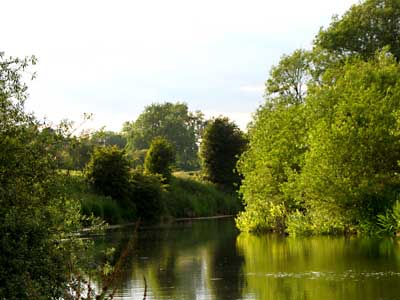
A lovely stretch of the Swale. Where would you fish in swims like these?
The guys I spoke to last Friday were all fishing pretty much as I’ve described in classic Swale barbel swims – a patch of bare earth at the bottom of a steep flood bank. Most of them were fishing pellet, normally loose fed by catapult, with a pellet or boilie fished over the bed of bait on a straight lead setup. So what did I do differently and why did it work? Come with me to the River Swale…..
I’ve told the tale of my first trip of the season in a previous article, but let’s revisit the session and look in more detail at what I did and why I did it. I arrive at 4 o’clock on a beautiful early Summer’s day to find the river as low as I’ve ever seen it, but with a tinge of colour from showers up in the dales. I’m not sure whether the barbel have begun to spread out along the river or are still in the shallows after spawning so I pick a swim in a broad glide above a long expanse of fast, shallow water.
Most anglers who fish this swim would either make the long cast over to some far bank trees or fish at some random distance out into the flow. From my vantage point behind a tree at the top of the flood bank I can see a little known feature about a third of the way across the river. It’s a large reclining pillar of rock which at normal levels only betrays its presence by the boil it leaves on the surface. I know from experience that a bait presented in the scour along the nearside of the boulder will consistently produce barbel.
My tactics are to fish two rods, both with the same set up of a Drennan 20g medium cage feeder, a long hook length and a hair rigged 8mm halibut pellet. One rod is fished slightly upstream and the bait is dropped into the top of the scour hard against the upstream end of the boulder. The second rod is fished about 5 yards directly below the boulder. I catapult a small pouch of pellets just upstream of the boulder to create a ‘smell lane’ downstream and then out go my two baits. I keep both rod tips low and pinch a small amount of tungsten putty around a powergum stop knot 2ft above the feeder to make sure my main line is pinned to the bottom.
The upstream rod will be recast at half hourly intervals to create a small, tight feeding area against the boulder and the downstream rod will be left out for as long as I think the pellet will last (about an hour and a half). My reasoning is that if there are barbel present around the boulder I’ll get my first bite on the upstream rod, but if there are no barbel present I should get my first bite on the downstream rod as barbel move up into the swim. Either way I want the main feeding zone to be against the boulder where the barbel feel safe.
I get no bites during the first hour so I resign myself to a long wait until barbel move up into the swim. Sure enough I get my first fish, a chunky barbel of 9lb 14oz, on my downstream rod, followed shortly afterwards by a very long fish of 10lb 7oz on my upstream rod.
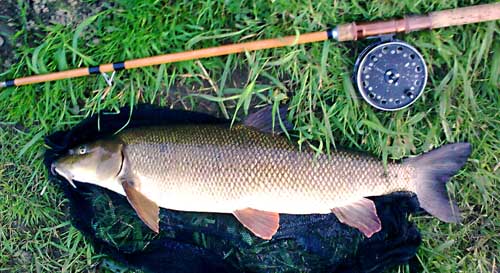
My first fish of the season
I’m busy at work so my next trip is a week later on a sultry Thursday afternoon. There are a few more anglers on the bank so I make a deliberate decision to fish a less popular area to avoid any disturbance. The swim I pick has two classic ‘barbel bushes’ on the far bank, but the lack of wear on my bank shows that they probably don’t consistently produce fish. This swim also holds a secret: a shallow gravel bottomed gulley about a rod’s length out from the near side. This gulley can only be seen when the river is low and exceptionally clear as it’s at least 6ft deep even in those conditions. When I fish this swim I always hedge my bets and fish one rod over to the bushes and one rod in the gulley.
The rod in the gulley nearly always outfishes the far bank rod, but I often get a bonus fish or two from the latter so it’s worth fishing across. My set up is exactly the same as last week although this time I’ll recast both rods at half hourly intervals. I take care to keep both areas of feed as tight as possible and I compress the pellets in the feeder of the far bank rod tightly so if I don’t land it within a foot of the bush I can retrieve and recast without spreading pellets around the swim. There is no cover on my bank, so even though the water is coloured by an algal bloom I keep low and move slowly.
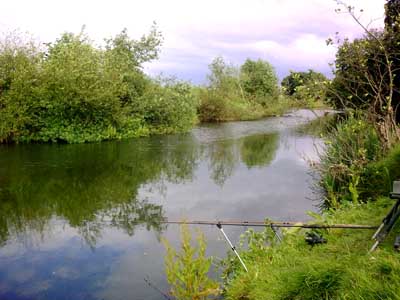
Can you spot the hidden feature?
I’ve got a wait of just over an hour before the near side rod is pulled sharply round and I’m into a hard fighting barbel of 8lb 11oz. This is one of the most beautiful barbel I’ve ever caught and I take a moment to admire its perfect proportions before I return it.
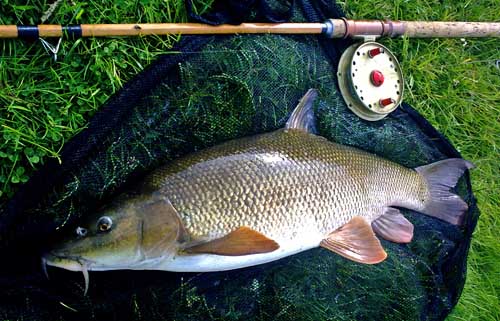
An hour later the near side rod goes again which results in a barbel of 6lb 15oz. The swim then dies, but I can’t complain about two nice fish on a lovely early Summer afternoon. I didn’t get an indication on the far bank rod.
Lessons Learnt
Anglers get fixated by surface features in swims and, almost without exception, every angler will fish a particular swim in the same way, presenting a bait close to the main feature. The few anglers who try something different are nearly always rewarded with higher catch rates.
Rivers are 3 dimensional environments and many features lie hidden beneath the surface. Some betray their presence with surface boils and swirls, but many others remain hidden. By walking the banks when the river is low and clear you can often spot these hidden gems and give yourself an edge.
Conventional wisdom has it that in low clear rivers barbel take refuge in weed beds or under dense overhanging cover during the day, only venturing out under cover of darkness. We are therefore advised to fish close to these areas and hope that a fish will venture out to take our bait. My experience is that some barbel will be out and about during the day and that whilst they may not be actively feeding they will often take a bait.
These wanderers will rarely deviate from their route to feed, so we need to present a bait directly in their line of travel, and this is where underwater features come in. In my opinion all barbel will take similar routes when travelling, navigating from feature to feature along their route. By presenting a bait close to these features we can be sure that a travelling barbel is likely to come across it. This explains my results on the two sessions I described above. On the first session I suspect that a small group of large fish were moving out into the river to feed. The boulder is a key landmark on their route and I intercepted them as they approached the boulder and then as they swam past it. On the second session I believe that I caught two individual travelling fish that were using the gulley as a landmark.
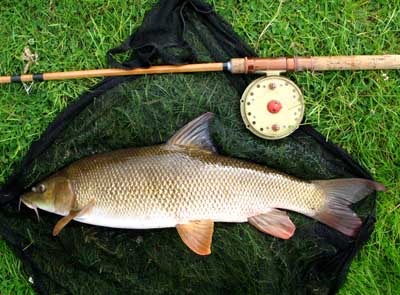
Travelling fish won’t stay in a swim for long so it’s important that you maximise the chances of them taking your bait by keeping the feed tightly grouped and not using too much. In clear water conditions you’ve also got to avoid spooking a fish by keeping your main line pinned to the bottom and by using a long hook length.
Even if I don’t know of the existence of a hidden feature in a swim I will often present a bait at different points around the swim on my second rod and by doing this I’ve found localised hotspots which have been much more productive than the more popular features in the swim.
So there it is. I’ve done nothing special in terms of bait or presentation and the only difference between me and other anglers on the bank is that I’ve fished close to hidden features that the barbel don’t associate with danger. This has given me an edge and ensured that I’ve caught barbel in difficult conditions. So learn the 3 secrets of catching consistently: location, location, location!
Sean Meeghan













